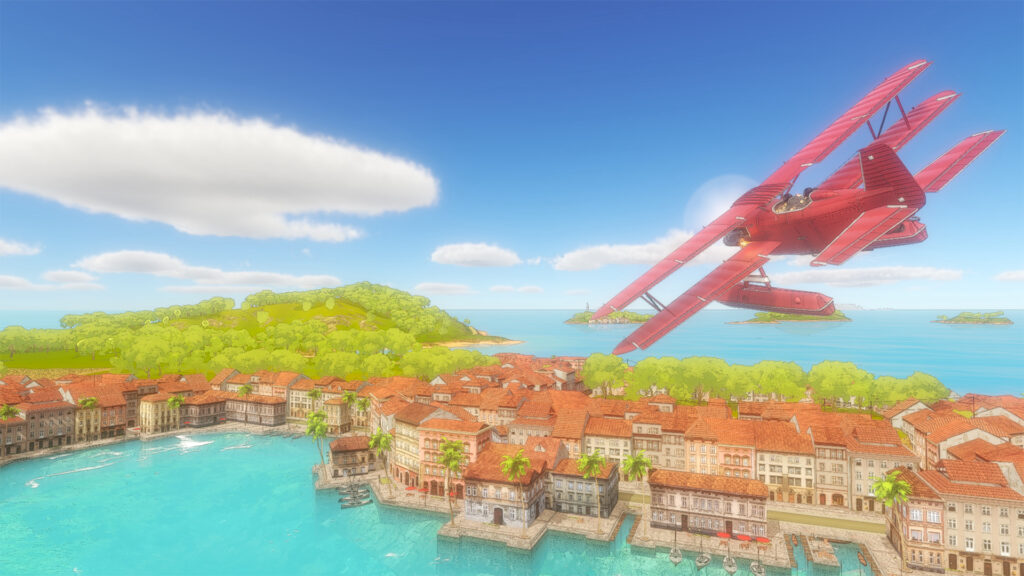As avid fans of Studio Ghibli’s animated movie Porco Rosso, Rob Hartley and Diccon Yamanaka were inspired to create a game about seaplanes flying around in a beautiful Mediterranean setting. The duo had recently departed from Relic Entertainment, where they had worked on titles such as Age of Empires 4 and Company of Heroes 2, to establish their own company, Lifetap Studios. Based in Vancouver, Canada, The Brew Barons is their debut title.
And for that debut the duo came up with an enticing mix of elements that really sets the game apart. “I feel our mix of arcade flight, light crafting, business/pilot management and plane parts with RPG-like traits, takes us into a new, unexplored genre of flight game”, says Hartley. But that’s not all. The Brew Barons also features aerial combat. “As we were prototyping there was still a feeling the game needed more action. We turned once more to Porco Rosso which features a band of mischievous but loveable pirates, so we added them to the game to help introduce some combat.”
The weaponry is quite unique as Hartley explains. “A vast majority of flying combat games have you launching missiles or spraying bullets at your targets, which is all good and fun. But we wanted our cast of pirates to be reoccuring, evolve as the player does and not be kill-able. We never want the player to feel too powerful, playing more of an underdog role, thus our heroes fight back and repel the pirates with water based weaponry and equipment normally used for farming irrigation. Fortunately with so much water all around the player is never too far from a refill to keep the fight going.”
Special plane shader
With Porco Rosso being such a great source of inspiration it feels only natural to have the game also look like a Ghibli film. A large majority of the art was created from scratch, but Hartley admits having used a few asset packs to help speed up development. “I have one rule regarding the use of asset store packages though, I’ll never use a package ‘as is’”, he says. “I feel there’s nothing worse than seeing an art asset in another game that’s identical to the one you’re using. Thus I make an effort to use purchased art assets only as a starting point to then be modified into something more unique and fitting of the aesthetic.”

Elaborating on the game’s aesthetics, Hartley feels particularly proud of the plane shader. It allows for players to create a pleasant looking paint job for their plane in a couple of clicks, and it’s also highly efficient. “Every plane part, wings, fuselage, pontoons, engine and such, plus every pirate vessel, they all run off just a couple 4098×4098 textures, a single material per entity. That’s very different to most games that tend to use hundreds of textures and multiple materials. Not only does this save a ton of texture memory and reduce draw calls, but it also sped up the creation process of parts, but admittedly at some cost of visual fidelity.”
Don’t aim too big
To keep development going in a constant motion, Hartley and Yamanaka kept to their specific roles as much as possible. “For stuff like gameplay balance and feature implementation we have equal input and chime up if there’s something we feel strongly about. Regarding the designing of traits, story elements, characters, mission objectives and dialogue writing, I took on most of that. Diccon took care of programming, visual scripting, Interface and controls.”

“For just two developers I think we took on too much work”, shares Hartley. “For me personally it spread me too thin across Art, SFX, Designs, Visual Scripting, Writing and Marketing Material. Each of which I feel comfortable doing, though with so many hats my time was limited. So, my advice is don’t aim too big if you’re a small team, especially with limited funds and the desire to self publish.”
Art versus Programming
“I would say Diccon and I have different approaches to development which can make things tricky, but ultimately isn’t a bad thing”, says Hartley. “I think it stems from our career backgrounds of Art versus Programming, which are somewhat opposite in nature since art is more free form whereas programming tends to follow certain rules. Diccon might prefer features to be well documented before implementation comenses, whereas I like to make rapid throwaway prototypes with an end goal in mind and see which designs feel best and let that lead the way. I think ultimately you need a bit of both styles.”

Now, after years of hard work, The Brew Barons is finally released. The indie duo feels relieved and a little bit anxious. “Most indie studios don’t survive long after their first release. It’s a competitive market, though I’m hopeful the game does well enough so we can build upon it further with more content, refinement, localization and a console release if it’s in the cards.”

